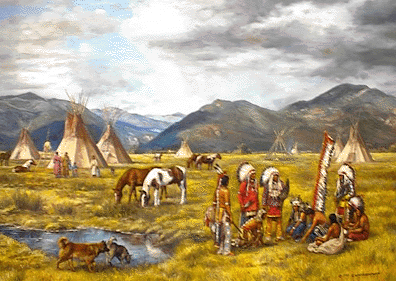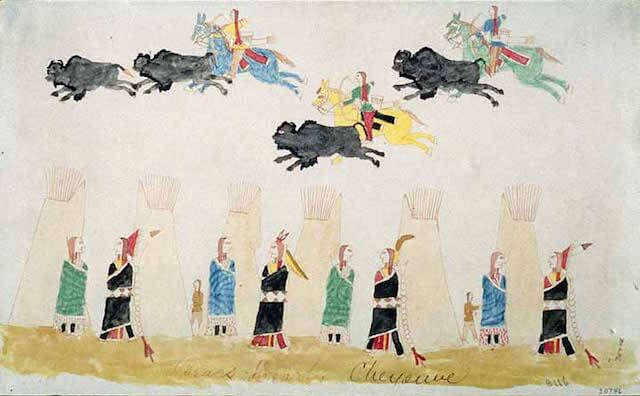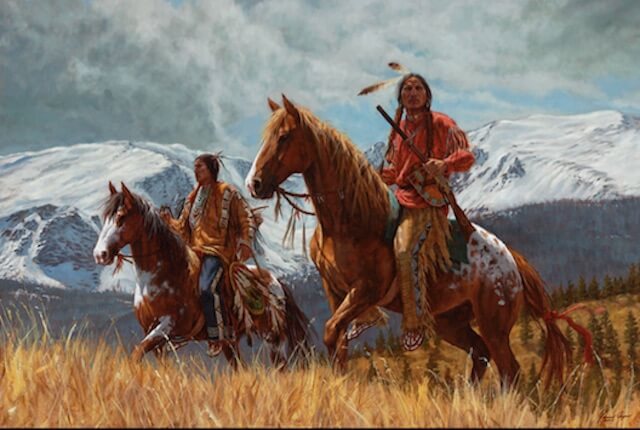"When all living things were birds and animals,
there was an old man who had power to heal the sick, and who
could see into the future. This old man prayed to the creator
so that his people could live in harmony with each other and
with all life forces and the universe. This old man became the
golden eagle, a messenger for his people to the creator. His
talons were strung together and worn by a medicine man; his
wing bones were made into whistles; and his feather and plumes
were used in religious ceremonies and worn in remembrance of
the Great Spirit."
The Cheyenne lived in a
valley next to a herd of buffalo. There was also a beautiful
bird that also lived there and every time the warriors went to
hunt the buffalo the bird would fly up and warn the buffalo
that the Indians were coming to kill them and they would flee.
Slowly the tribe was starving to death until a warrior decided
to do something about it; so one night he went out on the
prairie and dug a hole. He got into the hole and covered it
with limbs and grass and then placed some bait on top. The
next day the bird saw the bait and landed on top of the trap.
The warrior grabbed the bird and tied a cord to its leg. He
then threatened to punish the beautiful bird but the bird
begged and pleaded that he would never warn the buffalo again
so the warrior released him. The beautiful bird flew into the
sky and then laughed at the warrior and said; "I lied to you,
I lied to you. I am going to warn the buffalo." The warrior
then pulled the bird down from the sky by the cord and told
the bird that this time he would be punished.
The warrior built a smoky fire and turned the
beautiful bird over and over in the smoke and this is how we
got the CROW.
Source: Jack
Powell
Other Cheyenne Home Pages
Cheyenne
Society

Cheyenne Warrior
(Film by Michael B. Druxman)
Links
to
Other Cheyenne Home Pages
Tse-tsehese-staestse
(Cheyenne {shy-an'} )
Tse-tsehese-staestse is what the Cheyenne call themselves.
The word Cheyenne was believed to come from the French word
chien for dog. The French traders called these people this
because of the famous dog soldiers of the Cheyenne nation.
This is erroneous. The now accepted etymology of the word
Cheyenne is that it is the anglicized word Shyhela, which is
Sioux.
The Cheyenne people are the most western branch of the
Algonquian people. They originally came from the great lakes
area. There are many theories about why the Cheyenne moved
from the great lakes area. Most of them involve competition in
the area with the Ojibwe, Ree, and Mandan. They originally
lived as sedentary farmers in northeastern Minnesota, from
which they began migrating westward in the late 1600s; they
later settled along the Cheyenne River of North Dakota.
Dislodged ca.1770, they gradually moved southwestward; when
encountered (1804) by the Lewis and Clark expedition, they
were living as nomadic buffalo-hunters in the Black Hills of
South Dakota.
Cheyenne
Counsel

Religiously, the Cheyenne were guided to the plains area by
Maheo. They also were sent a prophet named Sweet Medicine who
helped organize themselves, and developed a code to live by.
He gave them their first sacred item -- the four sacred
arrows. It was at this point the Cheyenne became a powerful
force to be reckoned with. Their hunting territory extended
from the Platte River to what is now eastern Montana. A
southern group also had hunting grounds around the Arkansas
River. Another group of people known as the Sohtaio also
joined the Cheyenne. It is said that these two groups of
people were one day fighting, when the Cheyenne overheard the
Sohtaio speak amongst themselves. To their surprise, they
could understand the people. Peace was quickly pursued and
these people have lived with the Cheyenne ever since.
Eric Spotted Elk
In 1832 the tribe split into two branches, the northern
Cheyenne, who inhabited the area around the Platte River, and
the southern Cheyenne, who lived near the Arkansas River. The
Cheyenne were constantly at war with the Crow until 1840, when
an alliance was formed with the KIOWA, APACHE, and COMANCHE.
From 1857 to 1879 they fought white settlers and the U.S.
Army, especially after the brutal Sand Creek Massacre of 1864,
in which an estimated 500 Cheyenne were killed. The Cheyenne
played an important role in the defeat of Gen. George Custer
and the 7th Cavalry at the Battle of the Little Bighorn
(1876).
Cheyenne Lodges
The Cheyenne moved frequently: In South Dakota they lived
along the Cheyenne River and in the Black Hills. But bands of
their tribe were known in every western state. Before 1700 a
large group settled on the Minnesota River, and some Cheyennes
visited LaSalle's Fort in Illinois in 1680. Between 1780 and
1790, their settlements were attacked by Chippewas while
Cheyenne men were away hunting. Escapees settled on the
Missouri River near other Cheyennes.
Jerome
Bushyhead
Today the Cheyenne occupy two reservations, one at Tongue
River, Mont., and the other in southwestern Oklahoma. Their
population was about 7,500 in 1989.
Black Kettle Museum/Washita
Battlefield
Box 252 Cheyenne, OK 73628
Dedicated to Cheyenne Chief Black Kettle
and
Site of the 1868 "Battle
of the Washitas"
between General George Custer's
405-497-3929
Painting
of Roman Nose

 Return to Indigenous Peoples' Literature
Return to Indigenous Peoples' Literature
Compiled by: Glenn
Welker
ghwelker@gmx.com
Copyright
@ 1993-2016
This
site has been accessed 10,000,000 times since February
8, 1996.




